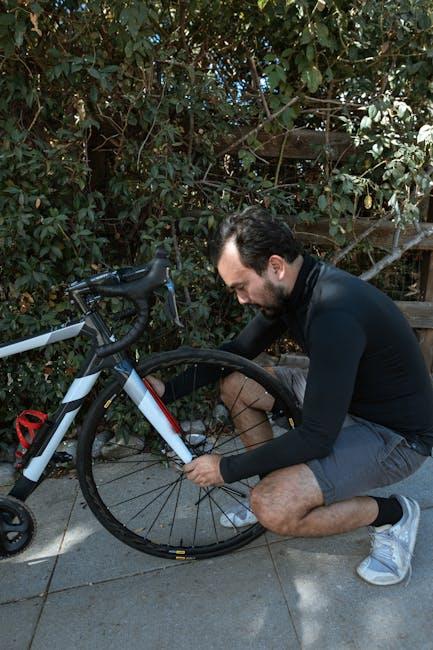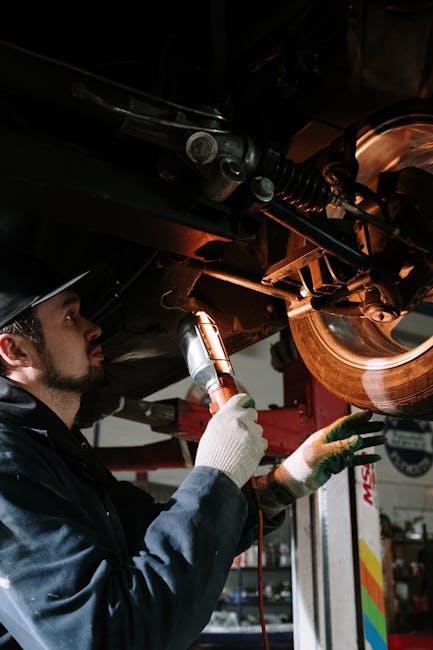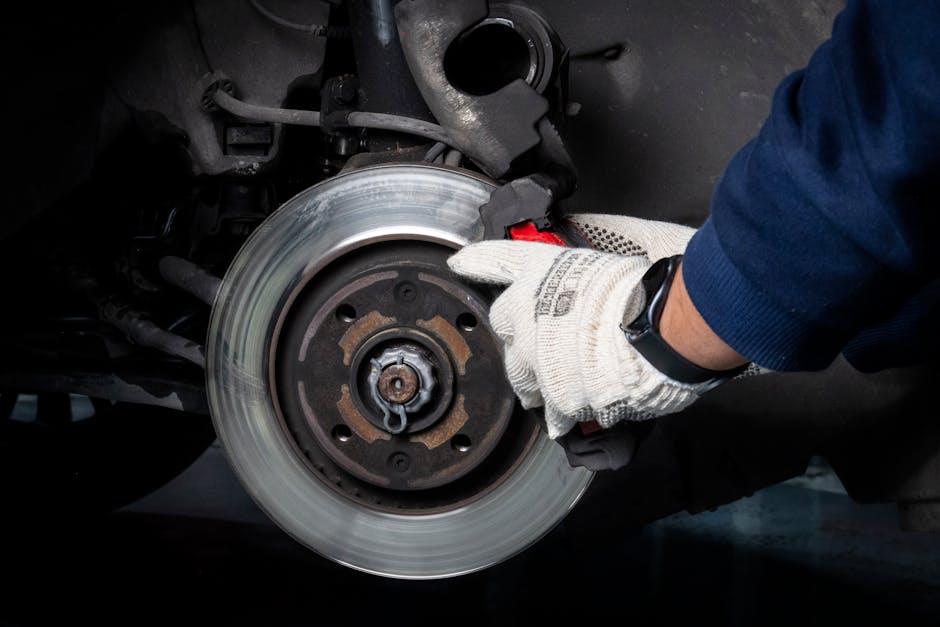Brakes are one of the most critical safety features on any vehicle, yet when they start to wear down, the repairs can often feel like an unexpected punch to your wallet. While no one wants to compromise on quality or safety, finding ways to save money on brake repairs is both smart and achievable. In this article, we’ll explore practical tips and insider insights that can help you keep your brakes in top shape without breaking the bank—because staying safe on the road shouldn’t come at an unmanageable cost.
Table of Contents
- Understanding Common Brake Issues Before They Escalate
- Choosing Quality Parts Without Overspending
- The Role of Regular Maintenance in Reducing Repair Costs
- DIY Brake Care Tips for Budget-Conscious Drivers
- When to Seek Professional Help to Avoid Costly Mistakes
- Comparing Repair Shops to Get the Best Value for Your Money
- Q&A
- In Conclusion

Understanding Common Brake Issues Before They Escalate
Recognizing the early signs of brake problems can spare you from hefty repair bills down the road. Common issues often start small but escalate quickly if ignored. For instance, a slight squeaking noise when braking usually indicates worn brake pads. Similarly, a spongy brake pedal might mean air in the brake lines or low brake fluid. By identifying these symptoms early, you can address them promptly and avoid damage to more costly components like rotors or calipers.
To keep your brakes in top shape without breaking the bank, focus on routine checks and maintenance. Here are key areas to watch:
- Brake pad thickness: Replace before pads reach the minimum thickness.
- Brake fluid level and quality: Top up and replace periodically to maintain hydraulic pressure.
- Brake rotor condition: Watch for warping or deep grooves that may require resurfacing.
- Brake line inspection: Ensure there are no leaks or cracks impairing brake performance.
| Symptom | Potential Issue | Consequence if Ignored |
|---|---|---|
| Squeaking noise | Worn brake pads | Damaged rotors |
| Spongy pedal | Air in brake lines | Brake failure risk |
| Pulling to one side | Uneven brake wear | Tire damage & unsafe driving |

Choosing Quality Parts Without Overspending
Finding the right balance between quality and cost when purchasing brake components is essential to ensuring your safety without draining your budget. Start by researching reputable brands that offer solid warranties—this often signals confidence in product durability. Don’t overlook the value of OEM (Original Equipment Manufacturer) parts versus high-quality aftermarket options; sometimes, the latter can provide a comparable level of performance at a more attractive price point. Additionally, consider buying parts in sets, such as brake pads or rotors, rather than individually, which can unlock bulk discounts and reduce the overall expense.
Before committing to a purchase, consult with trusted mechanics or online communities to get insights on which parts deliver reliability over time. Keep in mind the following guidelines to help you score quality parts affordably:
- Compare prices across multiple sellers—both online and local shops
- Check reviews focusing on longevity and performance, not just initial cost
- Look out for seasonal sales or coupon codes that apply to automotive parts
- Ensure compatibility with your vehicle’s make and model to avoid returns or extra costs
| Part Type | Average Price Range | Typical Warranty | Best Buy Tip |
|---|---|---|---|
| Brake Pads | $30 – $70 | 12-24 Months | Buy full axle sets for better deals |
| Rotors | $50 – $120 | 24 Months | Match with pads for optimal longevity |
| Brake Calipers | $70 – $150 | 12 Months | Consider refurbished units from reputable sources |

The Role of Regular Maintenance in Reducing Repair Costs
Consistent upkeep can be the most effective strategy to avoid expensive brake repairs. By adhering to a regular maintenance schedule, you catch minor issues before they escalate, preventing costly replacements and ensuring your vehicle’s safety. Simple practices like inspecting brake pads every 6,000 miles or having fluid levels checked during oil changes can extend part lifespans significantly. This proactive approach reduces wear and tear, allowing you to enjoy smoother, safer braking performance while keeping expenses in check.
Key maintenance actions that can save you money include:
- Routine brake pad inspections and timely replacements
- Brake fluid flushes to avoid corrosion and system failure
- Checking rotors for warping and grooves
- Ensuring calipers remain functional and free of debris
| Maintenance Task | Recommended Frequency | Average Cost Saved |
|---|---|---|
| Brake Pad Inspection | Every 6,000 miles | $100-$150 |
| Brake Fluid Replacement | Every 2 years | $200-$300 |
| Rotor Resurfacing | When worn | $150-$250 |

DIY Brake Care Tips for Budget-Conscious Drivers
Maintaining your brakes doesn’t have to drain your wallet. Start with regular inspections that can help you spot potential issues before they escalate into costly repairs. Look for worn pads, uneven rotor surfaces, and brake fluid levels. Keeping your rotors and pads clean with a simple wipe-down using brake cleaner can manage performance and extend their lifespan. Additionally, avoid riding the brakes to prevent premature wear—ease into stops and keep a safe following distance to minimize brake usage.
Investing a little time in basic maintenance will pay off significantly. Here is a quick reference guide showing common brake components, their average DIY replacement cost, and typical lifespan:
| Component | DIY Cost | Lifespan (Miles) |
|---|---|---|
| Brake Pads | $30–$70 | 30,000–70,000 |
| Rotors | $40–$100 | 50,000–70,000 |
| Brake Fluid | $10–$20 | 2 years (or 30,000 miles) |
Remember, sourcing quality parts and following manufacturer instructions can prevent mistakes and secure your safety. Simple upkeep like these DIY habits not only stretches your brake components’ durability but also helps you save a substantial amount on future garage bills.

When to Seek Professional Help to Avoid Costly Mistakes
Handling brake repairs on your own can save money, but knowing when to call in a professional is crucial. If you notice any of the following, don’t hesitate to seek expert help to avoid costly mistakes:
- Persistent squeaking or grinding noises despite your attempts at DIY fixes
- Uneven brake pad wear that you’re unsure how to diagnose
- Brake fluid leaks or low fluid levels that could indicate a bigger problem
- Soft or spongy brake pedal feel suggesting air in the brake lines or master cylinder issues
Attempting complex repairs without the right tools or knowledge can lead to further damage or compromised safety. Consider these factors before going it alone:
| Symptom | Risk of DIY Repair | Benefit of Professional Service |
|---|---|---|
| Warped rotors | Incorrect resurfacing or replacement causing vibration | Precision machining or expert replacement ensures smooth braking |
| Brake fluid contamination | Incomplete bleeding risking brake failure | Proper fluid flushes guarantee system integrity |
| ABS warning light | Misdiagnosis leading to untreated safety system faults | Specialized diagnostics to accurately pinpoint issues |

Comparing Repair Shops to Get the Best Value for Your Money
When hunting for a brake repair shop that offers true value, it’s important to look beyond the initial price. Quality of parts, labor guarantees, and customer service can significantly influence long-term savings. Start by researching reviews and asking for recommendations from trusted sources. Comparing warranty policies and the types of brake components used (OEM vs. aftermarket) can prevent costly redo jobs in the future. Often, shops that seem pricier upfront can save you money down the road with their expertise and durable parts.
- Verify certifications and experience—ASE certifications or specialized brake repair training matter
- Request detailed estimates with parts and labor clearly broken down
- Look for transparent pricing—beware of hidden fees or vague quotes
To visually simplify your decision-making process, consider this quick comparison of typical brake shop features:
| Criteria | Budget Shops | Mid-Range Shops | Premium Shops |
|---|---|---|---|
| Average Cost | $80 – $150 | $150 – $250 | $250 – $400+ |
| Warranty Length | 30 days – 3 months | 6 months – 1 year | 1 year+ |
| Parts Quality | Aftermarket | Mixed OEM & Aftermarket | OEM & High-End Brands |
| Customer Feedback | Mixed reviews | Generally positive | Highly rated |
By weighing these factors and comparing multiple shops, you ensure your hard-earned money stretches further, while maintaining safety and peace of mind on the road.
Q&A
Q&A: How to Save Money on Brake Repairs
Q1: Why do brake repairs often cost so much?
A1: Brake repairs can be pricey because they involve crucial safety components like pads, rotors, and sometimes calipers. The labor is also specialized; mechanics must carefully dismantle and reassemble parts to ensure everything functions perfectly. Plus, using high-quality materials can drive up costs, but it’s worth it for your safety.
Q2: Can I save money by doing brake repairs myself?
A2: If you’re mechanically inclined and have the right tools, DIY brake repair can save you a bundle. However, brakes are vital to your safety, so only tackle the job if you’re confident and knowledgeable. Otherwise, a mistake could cost more in the long run—or worse.
Q3: How often should I check my brakes to avoid costly repairs?
A3: Regular inspections, ideally every 10,000 to 15,000 miles or once a year, can catch wear before it becomes a major problem. Listening for squeaks or feeling for vibration when braking are good at-home signs you might need a pro’s look sooner.
Q4: Are aftermarket brake parts a good way to save money?
A4: Aftermarket parts can be a budget-friendly option, but quality varies widely. Look for reputable brands with good warranties and reviews. Cheap parts might save money upfront but could wear faster or compromise safety.
Q5: Can I stretch the life of my brake pads and rotors?
A5: Absolutely! Smooth driving habits, like gentle braking and avoiding hard stops, can extend brake life. Also, avoid riding your brakes downhill and give your system plenty of time to cool after heavy use.
Q6: What should I do if a mechanic’s brake repair estimate seems too high?
A6: Don’t hesitate to shop around—getting multiple quotes can reveal price disparities and help you find a fair deal. Also, ask your mechanic to explain the costs and what parts are needed. Transparency protects your wallet and builds trust.
Q7: Are there any maintenance tips to prevent unexpected brake repair bills?
A7: Keep up with fluid changes and bleed your brake system as recommended. Dirty or low brake fluid can cause corrosion and reduce effectiveness. Regular maintenance keeps your brakes functioning well and can prevent sudden, costly fixes.
Saving money on brake repairs isn’t just about finding the cheapest option; it’s about smart choices that keep your car safe and your expenses manageable. A little care and savvy can go a long way toward protecting both your brakes and your budget.
In Conclusion
Saving money on brake repairs doesn’t have to feel like a daunting challenge. With a little knowledge, proactive maintenance, and smart shopping, you can keep your brakes—and your budget—in top shape. Remember, taking care of your brakes isn’t just about stretching dollars; it’s about ensuring safety every time you hit the road. So, stay informed, stay cautious, and drive confidently knowing you’ve mastered the art of cost-effective brake care. Your wallet and your vehicle will thank you.

